| |
A record of SA's electricity generation
|
|---|
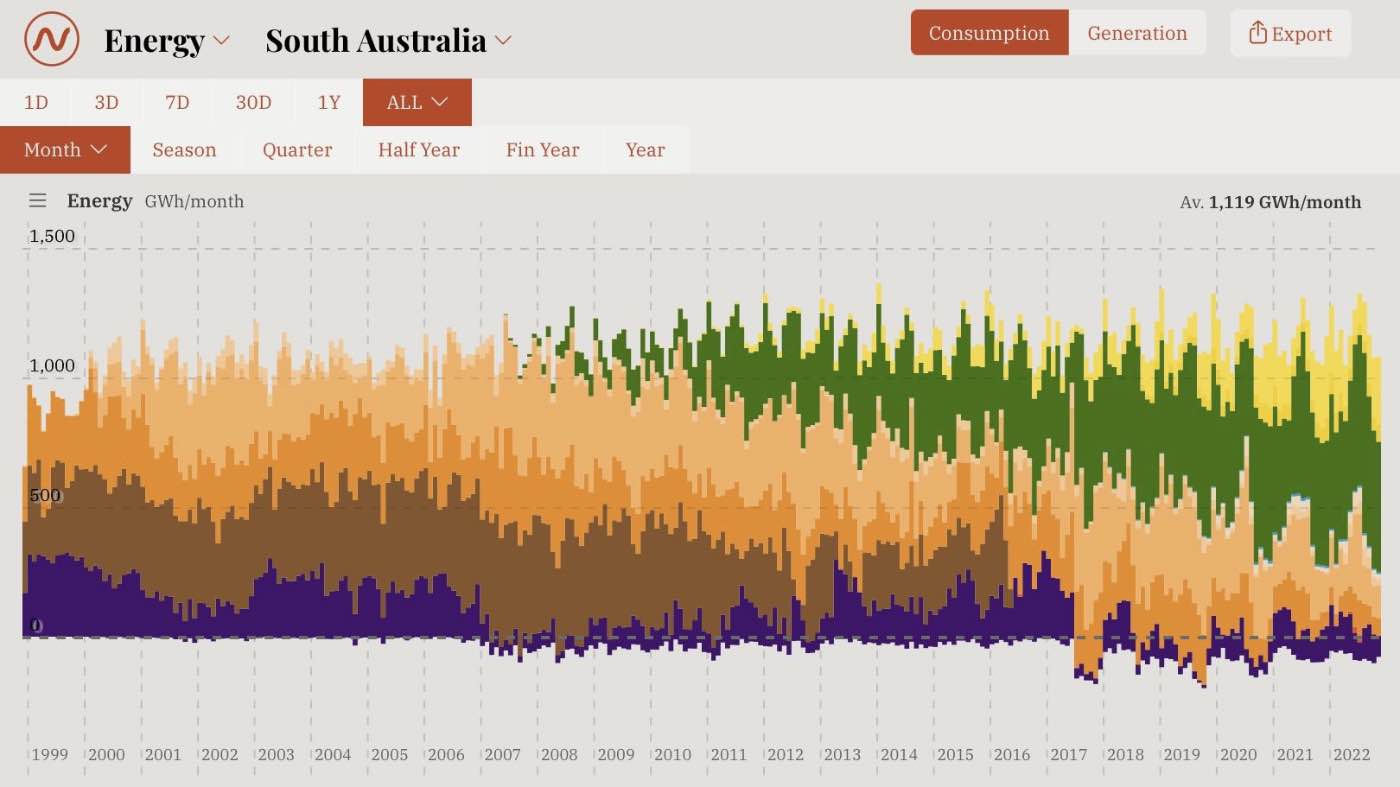
|
September 2020 was a record month for renewably generated electricity in SA, November (after this graph was imaged) was another record.
Graph credit: Open NEM. | |
The graph on the right shows a record of South Australia's generation over the period of the rise of renewable energy up to recent times.
Note the end of coal-fired power generation in May 2016.
| |
A record of South Australia's power generation for the year to late January 2020
|
|---|
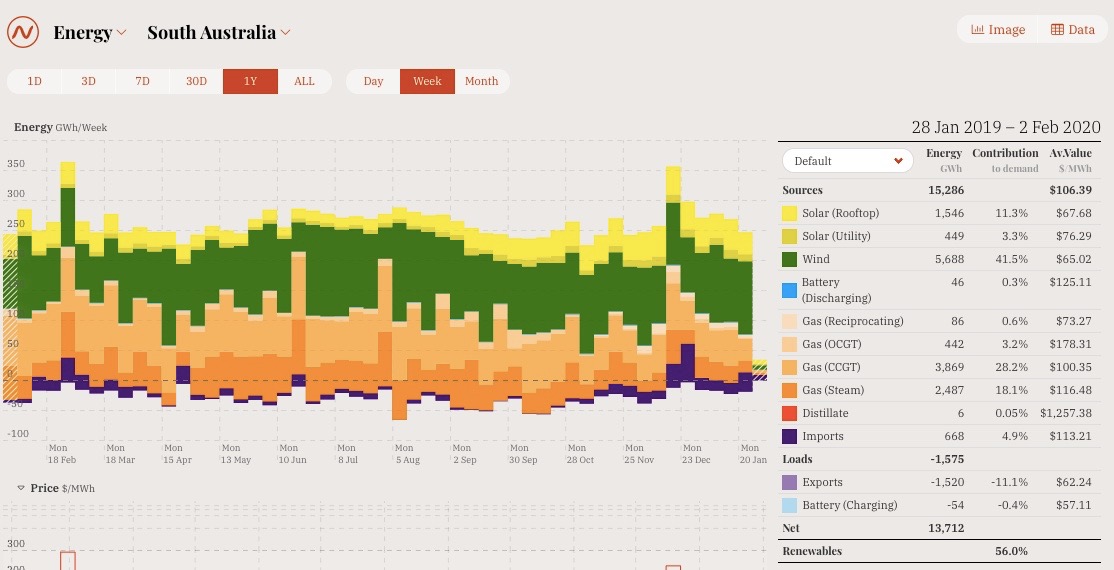
|
As the figure shows 56 percent of South Australia's electricity demand was provided by renewables over the last year, made up of 41.5% wind, 11.3% solar rooftop and 3.3% utility scale solar.
During the year SA imported 4.9% if its demand, and exported more than twice as much, 11.1%.
All three, wind, solar rooftop and utility solar are increasing all the time, and we've hardly started yet.
Graph credit:
Open NEM.
I can highly recommend this site to anyone interested in the ins and outs of the National Electricity Market (NEM).
| |
The graph on the right shows energy generation in SA in the year ending 2020/01/27.
The caption shows the sources of the energy generation.
The purple segments scattered along the bottom of the graph show energy imported from Victoria, the segments below the Generation=0 line (the dashed line near the bottom) are energy exports to Victoria.
Wind generation has been periodically limited, that is, the generation of some wind farms has been intentionally reduced (the technical term used is 'curtailed') for two reasons:
- The Australian Energy Market Operator (AEMO) wants to keep a minimum amount of gas-fired generation running at all times for stability of the grid;
- Generation sometimes exceeds the total of consumption and the capacity of the interstate interconnectors.
| |
The need for backup (peaking power, power on demand)
The period of low wind generation (high gas generation, shown as pink on the left side of the graph above) from about 4 pm on July 31 st to 9 pm on August 1 st represents a shortfall of from 700 MW to 1,700 MW of renewable power and about 20 GWh of renewable energy.
This is something like 13 times the energy storage expected to be available from the
proposed Baroota Reservoir pumped hydro development (and 150 times the energy storage of the
Hornsdale Power Reserve aka the Tesla Big Battery.)
|
|
Considering the above the present constraints on SA's electricity generation development are related to:
- An increasing amount of renewable energy being developed – to the point where generation is increasingly frequently greater than consumption;
- Limited local consumption;
- Limited capacity to export electricity;
- Very little energy storage.
There is a section on constraints
elsewhere on this page.
I have discussed
how Australia should generate its electricity, the need for energy storage such as
pumped hydro and the
myth of base-load power elsewhere.
| A part of one of about 11 wind farms or wind farm groups in South Australia at the time of writing
|
|---|

|
| Wattle Point Wind Farm, Yorke Peninsula, South Australia
|
| |
Clare polling booth, Australian federal election, 2019/05/18
|
|---|

|
School kids Niamh and Emma asking for the world that they will inherit to be protected.
They and many others were disappointed, the
corrupt and coal-loving Liberal/National coalition was re-elected. | |
- South Australia has a large amount of installed wind power; so large that it sometimes exceeds the total of the state's power consumption and the capacity of the interstate interconnectors;
- There are two interconnectors between SA and Victoria, but their capacity is sometimes less than needed for both importing and exporting power;
- A proposed interconnector with NSW seems close to being approved;
- More wind and solar power is being developed, and far more has been proposed;
- About a third of South Australian houses have roof-top solar power, the proportion of commercial premises with solar is probably similar;
- Utility scale solar power at the present is small, but is about to become a major factor in the generation/consumption equation; in a decade or so it could become as large as present wind power generation;
- There is little
energy storage in the state and the amount proposed to be built in the near future is not sufficient to cover foreseeable needs, however, the various technologies involved are developing quickly;
- There is sufficient gas generation to fill in when the wind isn't blowing and the sun isn't shining, but the few operators in the market are able to manipulate prices to their advantage at such times;
- For the present at least, I believe that the Australian Energy Market Operator (AEMO) is not allowing new wind farms to be built without some energy storage being included.
| |
This section added
2023/09/15
|
|
Open NEM showed that in the year to September 2023 just over 70% of SA's power demand was generated renewably: 45.5% wind, 19.1% roof-top solar and 5.6% utility solar.
This was a higher percentage of roof-top solar than any other state (WA had 16.3%) and twice the percentage of wind power than any other state (Victoria had 22.7% wind generation). It was a far higher percentage of renewable energy than any other state except Tasmania (which has abundant hydro power), Victoria had 41% renewable power.
Determined attempts have been made to develop hot rock geothermal energy in SA.
They have thus far failed to prove economically viable.
| |
Peterborough 4.9 MW Solar Farm
|
|---|
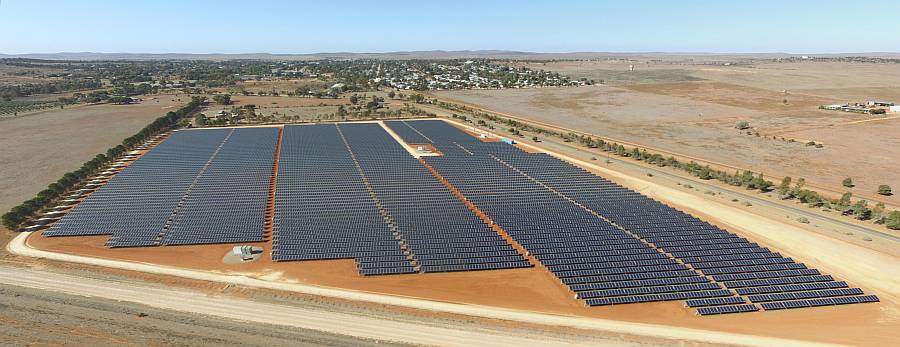
| |
Photo taken using my drone, 2018/05/12.
Peterborough township in the background.
The solar farm had not long been completed.
| |
In this section I have outlined the changes that are in the process of happening or seem very close to happening.
I've listed the more speculative and exciting developments in the
game-changer section and some of the
technical challenges below.
There are a great many rooftop solar PV installations in SA, typically no bigger than 5 kW and rarely bigger than 100 kW; there is scope for far more.
| |
A winery in the Clare Valley
|
|---|
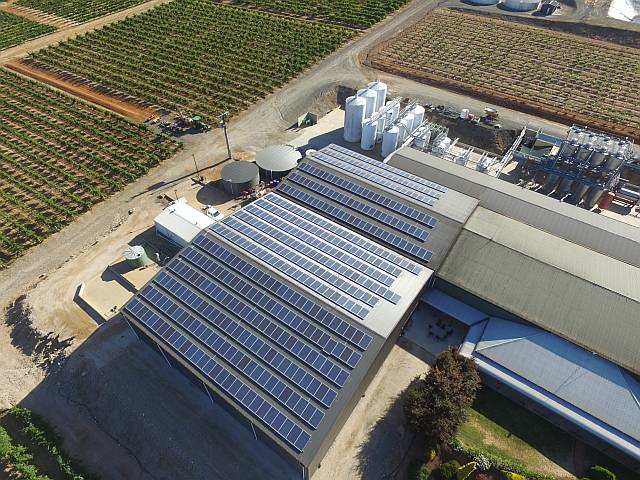
| In South Australia wineries have been early adopters of solar PV
| |
At the time of writing a number of utility-scale solar PV farms were either under construction or proposed in South Australia, some of these were in excess of 100 MW.
It seemed likely that any new wind farm would include a significant solar PV component and/or battery.
Just one of the more interesting solar developments happening at the time of writing was
Solar River Project, stage 1 being 200 MW solar with a 120 MWh battery, expected to come on-line in late 2019; stage 2 another 200 MW solar with a 150 MWh battery, construction expected to start in late 2019.
There are others of similar sizes proposed for Mintaro, Whyalla and Tailem Bend; and the Bungama Solar Farm at Port Augusta was near completion of the first of two stages.
| |
Sundrop Farms – the solar power installation
|
|---|
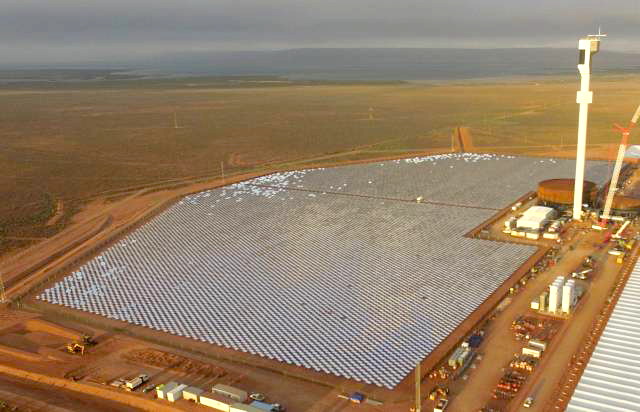
| |
A small part of the greenhouse is just visible on the lower right.
Heat is stored in molten salt in the large tank on the right behind the tower.
Photo taken with my drone 2016/03/14
| |
At the time of writing
Sundrop Farms, near Port Augusta in South Australia (photo on the right) was the only significant development of solar thermal power with energy storage in the country.
It is not used to generate grid electricity, it powers a huge greenhouse including desalination of the very salty water supply.
The proposed 150 MW
Aurora solar thermal power station project at Port Augusta which was to include 1,100 MWh of energy storage has been abandoned.
My impression is the solar thermal power cannot compete with solar photovoltaic, due to the economies of scale of the latter.
In early 2020 it was expected that construction would start about June on the big
Port Augusta Renewable Energy Park (wind and solar) and planning permission had been given for the innovative
Crystal Brook Energy Park (wind, solar PV, battery, possible hydrogen).
Several other wind farms had been proposed.
| |
This section added
2019/02/15
Edited 2020/02/04
|
|
At the time of writing there were two interconnectors between South Australia and the remainder of the NEM (National Electricity Market), both connected with the Victorian grid.
- The capacity of the Heywood Interconnector was increased from 460 MW to 650 MW in mid 2016.
- The Murraylink direct current link has a capacity of 220 MW.
So the maximum amount of power that SA could export with these two interconnectors was 870 MW.
(Just in the week prior to writing this section, that is from 2019/02/08 to 2019/02/15, there were four quite separate occasions when the amount of power being exported from SA was above 600 MW and four occasions when imported power reached over 400 MW.)
| |
Failure of Heywood Interconnector, January 2020
Six towers on the Heywood interconnector caused the loss of about three quarters of South Australia's ability to export and import power from the National Electricity Market.
It was expected that repairs would take two weeks.
With climate change expected to increase the violence of storms it seems that long transmission lines will become increasingly unreliable.
While greater interconnections between regions and states will be valuable for the medium term, the long term will require more local sources and sinks for energy.
|
|
In February 2019 transmission network companies ElectraNet and Transgrid delivered their final report into their proposal to build a $1.5 billion link between Robertstown in South Australia and Wagga Wagga in NSW. They have dubbed the project “EnergyConnect”.
For more information on the proposal see
Renew Economy.
This will be a boost for the renewable energy industry in both states, but particularly for SA, and consequently help to reduce Australia's greenhouse gas emissions.
It is proposed that the new interconnector will have a capacity of 800 MW, which is about a half of the typical electricity generation in South Australia.
At the time of writing there was increasingly often more renewable energy generation in SA than could be used in the state or exported via the existing interconnectors to Victoria.
AEMO's Quarterly Energy Dynamics report for the forth quarter of 2018 stated that:
"Curtailments of non-synchronous (wind) generation in South Australia amounted to 4% of available generation for the quarter, down from 10% in Q3 2018."
This amounts to a substantial loss of earning power as well as being a loss of clean energy that could go toward displacing fossil fuelled power and reducing emissions, and it will only increase as more renewable energy comes on line.
The new interconnector will allow increased wind and solar development in SA because any excess, beyond local consumption, will be able to be sent to NSW, displacing coal power there.
There are times when there is wind in SA and not in the eastern states (and vice-versa), so the new connector will allow states to help each other at these times.
Solar power generation in SA peaks later (often an hour or more later), and continues later in the day, than in NSW.
Often the peak demand on the NSW power grid comes when solar power in SA is still generating substantial amounts of electricity; the new interconnector will allow this to be sent to the east.
Energy stored in one state will more readily be able to be used in the other state, when needed.
It is expected that the interconnector will be completed about 2022.
| |
This section added
2020/05/26
|
|
| |
Update 2021/02/12
Giles Parkinson reported that AEMO was to allow an increase in the maximum renewable generation on the SA grid from about 1750MW to about 2000MW because of the increased stability to come with the syncons.
|
|
In May 2020 Giles Parkinson wrote an
article for Renew Economy reporting that four synchronous condensers were to be installed in the South Australian grid to remove some of the need for our polluting gas fired power generation. Two were being installed near Port Augusta, two more near Robertstown; others were also being installed in the eastern states.
The syncons, as they are called, provide 'system strength' and other services to stabilise the power grid. These services have in the past been provided by spinning gas- or coal-fired generators.
Of course the
Morrison federal government is trying to ignore the fact that this can be done, so that they can try to justify continuing to support the fossil fuel industry.
The dominant forms of sustainable energy generation, sun and wind, are variable so it will be essential to store energy when it is plentiful so that it can be used as it is needed.
There are many ways of doing this, and the technologies are being developed all the time.
Pumped hydropower
Two pumped hydro proposals that seem likely to be built in South Australia in the near future are
Goat Hill, 220-270 MW, 1.8 GWh and
Baroota (photo in the
Potential section and mentioned above), 200-270 MW, 1.6 GWh.
Both of these are in the upper Spencer Gulf area.
For comparison the Hornsdale Power Reserve, the biggest battery in the world when built, has a capacity of 100 MW, 0.129 GWh.
A low wind period lasting a couple of days can leave an energy short-fall of 30 GWh, so plainly far more energy storage than will be provided by these two projects would be useful.
(By comparison the Energy Connect interconnector discussed above could deliver 19 GWh in a day.)
Batteries
Bloomberg New Energy Finance, as reported in
The Sydney Morning Herald by Cole Latimer, 2018/11/07, has suggested that Australia is set to be a leader in what will become a $1.7 trillion battery industry.
Bloomberg NEF says that Australia will be one of the nine countries leading this battery charge.
A factor that must be considered is that batteries and pumped hydro will be most economically viable if they cycle once a day.
Whether they can be economically justified if only used once a week is questionable.
My impression is that high-capacity long-distance interconnectors will be needed for at least the foreseeable future.
Batteries as 'Virtual' power plants
At the time of writing several pilot projects were underway testing the practicality of integrating household batteries and household solar into the state power grid.
The expectation was that this could add flexibility in matching generation to consumption.
In September 2018 the SA (Liberal!) government was aiming at building
the world's largest virtual power plant that would eventually include a total of 50,000 houses, 250 MW of solar power and 250 MW/675 MWh of battery storage.
| |
This section added
2023/04/26
|
|
Excess electrical energy can be used to produce hydrogen which can then be stored. Hydrogen is difficult to store cheaply except in salt caverns.
| |
A proposal in South Australia
A very big wind farm aiming at producing hydrogen with storage in salt caverns has been proposed in South Australia's Eyre Peninsula.
|
|
This is of particular relevance to the hydrogen storage potential in salt beds on western Eyre Peninsula in South Australia.
A quote from Ent X, a business that has proposed a salt cavern hydrogen storage on Eyre Peninsula, "Bloomberg NEF reports levelised cost of hydrogen storage (LCOS):
- engineered tanks US$2.30/kg;
- depleted gas field US$1.90/kg;
- rock cavern $0.71/kg;
- salt cavern $0.23/kg".
A
document (on page 3) by Bloomberg NEF gives the above cost for salt cavern storage and also a 'Possible future LCOS' in salt caverns at $0.11. Both are far cheeper for long term (weeks or months) storage for large volumes than any alternative.
I've written more on this page about the advantages of bringing Eyre Peninsula into the National Electricity Market.
Energy storage as heat
Energy can be stored as
heat.
It has long been stored in the form of heat in hot water, both domestically (a domestic water heater is a storage of thermal energy) and industrially.
One of the great advantages of solar thermal power stations is that it is easy to integrate energy storage with them, usually in the form of molten salt.
Storage of energy is also being explored in molten silicon.
At the time of writing (August 2019), molten silicon was looking promising.
According to
Wikipedia molten silicon can store a megawatt-hour of energy in each cubic metre; a very high energy density.
The technology was
said to be on the cusp of commercialisation in South Australia at the time (August 2019).
Peaking power
At least until various forms of energy storage (such as
pumped hydro) can fill in the generation gaps from renewables we will need peaking power, which currently means gas-fired generation, but there seems to be no need of more in the foreseeable future.
With the current growth in renewables and energy storage there is absolutely no need for new base-load (coal or nuclear) power in South Australia (or, for that matter, in Australia).
On the matter of base-load power generation the
National Energy Emissions Audit from The Australia institute of August 2019, written by Hugh Saddler, stated:
"South Australian electricity supply system provides real world evidence of how a new base load generator, such as a nuclear power station, could not be incorporated into a system with a high proportion of variable renewable generation. The best complement for high renewables is storage and a diversity (in location and type) of renewables."
While in 2019 SA was well ahead of the other mainland states in the adoption of renewable energy, wind power in particular, the eastern states were catching up. Tasmania too would not have any use for a base-load power station, because of its very high level of hydro power and increasing wind power.
I have discussed the
myth of base-load elsewhere.
In-situ gasification (ISG) has been trialled at Leigh Creek in the Northern Flinders Ranges (in the same coal beds that were used to supply the Port Augusta power stations).
In terms of carbon intensity (the amount of carbon dioxide released per unit of useful energy obtained) ISG is
worse even than mining and burning coal.
It is the least attractive option for producing energy from the point of view of greenhouse emissions minimisation.
With ISG the coal is partially burned underground, releasing carbon dioxide, carbon monoxide, methane and hydrogen.
Later the carbon monoxide, methane and hydrogen are burned to obtain useful energy, releasing more carbon dioxide, and steam.
Another major risk of the process is that some of the methane generated in the coal seam is likely to leak into the atmosphere.
Methane is a very active greenhouse gas, far more active than carbon dioxide.
It would be a serious backward step, ethically and environmentally, for ISG to be used in South Australia's energy future.
Reliability
On the point of reliability,
AEMO's Electricity Statement of Opportunities, September 2017 forecast "From 2018–19 to 2021–22, progressively decreasing levels of
potential USE [Unserved Energy - power failures due to insufficient generation] conditions are observed over the next four summers, due to increasing renewable generation." The AEMO report foresaw the highest chance of a USE event happening in financial year 2017/18. There were none in SA in that period.
Morrison federal government, new Energy Minister
It was announced on 2018/08/26 that Angus Taylor was to be Australia's Energy Minister.
I hope for the sake of the nation and the world that Mr Taylor is far better informed on energy than he was back in 2012.
I had an argument with Angus about wind power on his Facebook page back then, when it became clear he was losing the argument he deleted it.
Fortunately I kept a copy.
In February 2019 it was looking very unlikely that the Morrison Government would remain in power following the May 2019 election.
Future federal governments
Will Labor replace the Coalition at the next election?
Getting into the realm of fantasy, will new PM Morrison take Australia's climate change obligations seriously?
South Australia's state government
A long-standing Labor government was replaced by a Liberal government in March 2018.
It seems that the new Liberal government has recognised the value of SA's renewable energy and the fact that almost everyone in Australia
wants more renewable energy.
While they show no sign of criticising the federal COALition government they seem to pose no danger to further renewable energy development.
|
|
|
Wind resource map of Australia
|
|---|
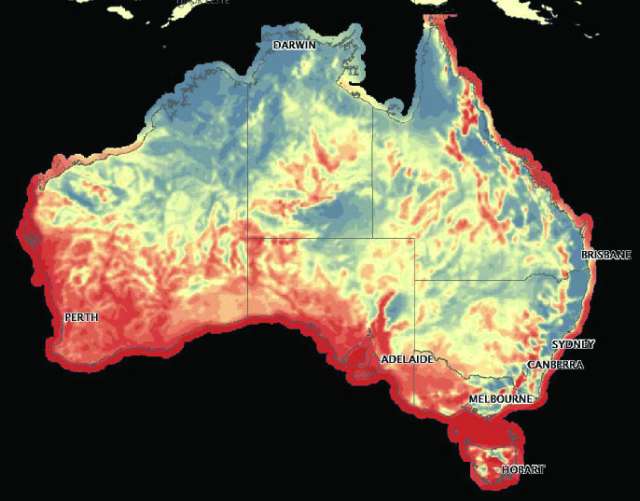
| Image from
Aust. Dept.
of the Environment, Renewable Energy Atlas of Australia
(Apparently no longer available – 2011/03/18)
|
|
Onshore wind power
The map on the right shows the best wind power resource areas in Australia in red.
At the time of writing wind power development in South Australia has been confined to areas that were close to existing high capacity power lines; not a single transmission line has been built (anywhere in Australia) to connect an area of high wind potential to the NEM (National Electricity Market) or the SWIS (SW Interconnected Network) in WA.
Ironically many of SA's wind farms owe their existence to the now-closed coal-fired power stations of Port Augusta.
Three (or is it four, I forget) high capacity power lines run the 300 km from Port Augusta to Adelaide east of Spencer and Saint Vincent gulfs through an area of predominantly north-south trending ranges of hills in a region of mostly westerly winds; ideal for wind farms.
There is still room for more wind farms near these power lines.
The map shows that Yorke and Eyre Peninsulas, west of Adelaide, have excellent wind power resources.
Wind power developments on both peninsulas have reached the small maximum imposed by the existing low-capacity transmission lines.
Eyre Peninsula; a barely touched wind resource
Importantly, the west coast of Eyre Peninsula, which is ideally suited to wind power development, is about 300km west of Mid North SA where most of the state's current wind power is concentrated.
Weather systems in the region generally move from west to east, so wind farms on the West Coast would pick up the power available in these systems several hours before other wind farms.
A large geographic spread of wind farms is important in reducing the variability of generation.
On 2019/03/24 wind generation in SA went from 314 MW at 1000 hrs to 1281 MW at 1230 hrs, an increase of 967 MW in two and a half hours.
On 2019/03/29 wind generation in SA went from 127 MW at 0000 hrs to 1014 MW at 0300 hrs, an increase of 887 MW in three hours.
If there were several high-capacity wind farms on the west coast of Eyre Peninsula they could make use of wind events such as these several hours before they reached the wind farms of the Mid North and, of course, many hours before they reached the wind farms of the eastern states.
Onshore wind power, last word
South Australia's current wind power, 1.8 GW at the end of 2017, could be doubled or even trebled if there was a power transmission system capable of taking the energy.
A greater geographic spread of wind farms could take advantage of winds blowing in one region but not yet in other regions, increasing and smoothing generation.
Offshore wind power
The map shows that there is huge potential for offshore wind power all along the southern Australian coast.
Australia at the time of writing had no offshore wind power, not even any proposed offshore wind power.
Offshore wind power has been much more expensive than onshore, but with substantial and greatly accelerating offshore development overseas costs have come down substantially; see
Unearthed and
Wind Power Monthly.
There are advantages to offshore wind power compared to onshore:
- There are no transport constraints due to road access, length limits, weight limits;
- Winds over the sea tend to be more consistent and less turbulent than those over land;
- Turbines can be bigger and turbine towers taller because they don't have to be transported by trucks, they are transported by ships;
- The problems due to nearby habitation that exist for some onshore wind farms do not arise;
- Turbine bases form anchoring points for marine life: a boost for marine biodiversity.
What is the potential of SA's offshore wind power?
It could exceed onshore, I'd say that 5 GW would be conservative.
| |
| The 137.5 MW first stage of Bungala Solar Farm, under construction
|
|---|

| | A composite of several drone photos taken during construction, 2018/05/10
|
|
|
|
|
Looking ahead
"Solar energy is vast, ubiquitous and indefinitely sustainable. Simple calculations show that less than 1% of the world’s land area would be required to provide all of the world’s energy from solar power – much of it on building roofs, in deserts and floating on water bodies.
Solar systems use only very common materials (we could never run out), have minimal need for mining (about 1% of that needed for equivalent fossil or nuclear fuels), have minimal security and military risks (we will never go to war over solar access), cannot have significant accidents (unlike nuclear), and have minimal environmental impact over unlimited time scales."
The above quote is from an
article in The Conversation, 2020/01/16, written by Andrew Blakers.
| |
At the time of writing the most northerly South Australian solar PV farm was Bungala near Port Augusta, shown in the photo on the right when under construction.
Port Augusta is at the northern extremity of Spencer Gulf and about 300 km north of Adelaide.
Australia's only proposed solar thermal power station,
Aurora, is also to be at Port Augusta.
Solar power resources at Port Augusta are as good as any anywhere on the NEM grid, that's why these power stations are there (or are proposed to be there); however, the solar resource gets progressively better north of Port Augusta.
Eyre Peninsula also has big solar power potential and, since it is further west than any other place connected to the National Electricity Market (NEM) its solar is available later in the day (40 minutes later than Melbourne, an hour later than Sydney).
This coincides very well with peak demand times in the remainder of the NEM.
However, the Eyre Peninsula solar resource (like its wind resource) cannot be developed until increased transmission capacity is built.
Plainly the potential for solar power development in the huge area north of Port Augusta – about 2/3 of the state – is mind-boggling.
All that is lacking for its development is transmission lines and a market for the power.
The area of the part of SA north of the settled districts is around 700,000 km
2.
Solar farms in that area could be expected to have installed capacities of at least 40 MW/km
2.
So, if 1% of the area of northern SA was covered in solar panels the capacity would be 280 GW and this would generate around 600 TWh/year, more than twice the total annual Australian electricity consumption.
| |
| Baroota Reservoir; proposed for use for pumped hydro – see text
|
|---|
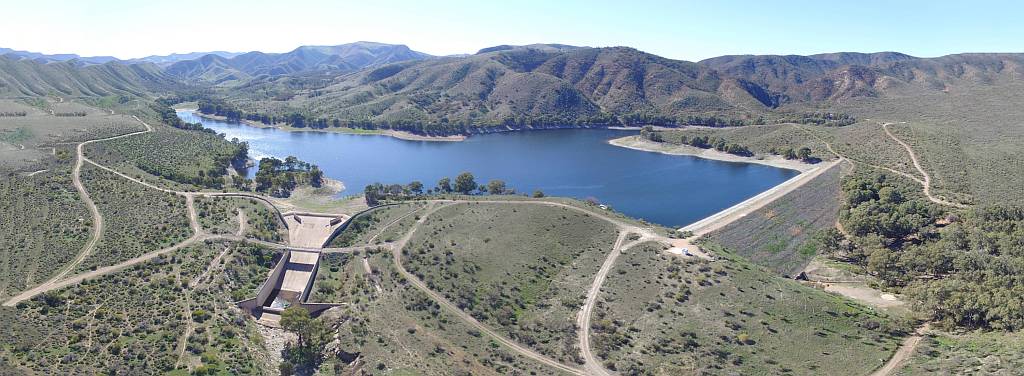
|
Photo taken using my drone, 2018/08/21.
The upper reservoir will be near the top of the ridge in the background, 200 m above the water level of the dam; a drilling rig may be seen on the ridge in high-definition version of this photo.
| |
At the time of writing there was negligible utility-scale energy storage in South Australia, the
Hornsdale Power Reserve (aka the Tesla Big Battery) stored a maximum of 129 MWh; as mentioned above, we need many gigawatts.
An Australian National University group under Andrew Blakers
identified 5000 sites in mid 2017 each seven to 1000 times larger than the Hornsdale Power Reserve; that is, bigger than 1 GWh.
Apart from capacity,
pumped hydro has a huge advantage over batteries in its longevity; while a battery can be expected to last for a decade or so, most of the components of a pumped hydro installation will last many decades.
On top of this is the question of the recyclability of the components of a battery.
| |
An early pilot floating solar power installation
|
|---|
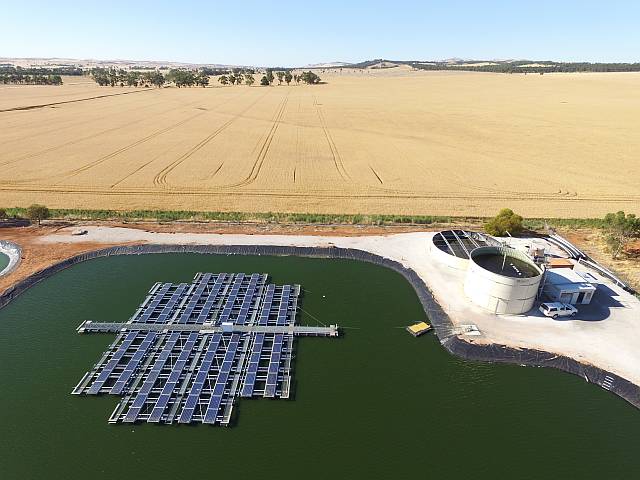
| On common effluent ponds at Jamestown in Mid-North South Australia. Photo 2016/12/12
| |
However, while pumped hydro energy storage will certainly be useful for filling in the generation gaps in the local grid I don't see it as the game-changer that energy export could constitute.
Evaporative losses from water storages is a major problem in Australia.
While most pumped hydro storages are not large, evaporation losses will still potentially be significant.
However there are ways of reducing the losses, even of making good use of the area available to generate more renewable electricity.
In early 2018 a 100 kW floating solar farm had been completed on effluent ponds in Lismore, NSW, with a proposal of installing another 500 kW later.
The photo on the right is of an early (2015) pilot installation at Jamestown, South Australia. The plan was for the whole of the three ponds that made up the treatment works would be covered with floating solar panels in the long term. For some reason it came to nothing and these panels were removed.
Solar panels have been installed on a bigger scale, a megawatt,
over
irrigation channels in Gujarat, India in a project expected to reduce
evaporation by 34 ML per year.
Forty megawatts of floating solar panels have also
been
installed in an area flooded due to coal mining subsidence in China.
More information
I've written more on
pumped hydro and
pumped hydro using old mines elsewhere.
| |
This section added
2019/12/08
|
|
| |
| South Australia's power generation over one day
|
|---|

| South Australia's power generation sources over a 24 hour period, 2019/12/07-08
Image credit
Open NEM
| |
The graph on the right shows how wind power and solar power can, and do, complement each other.
When the sun is not shining (more accurately, when the light is not bright, solar power is also generated under cloudy conditions) the wind may be blowing and wind power abundant; as in the right-hand side of the image on the right.
When the wind isn't blowing there may be abundant solar energy, as in the left-hand side of the image.
In South Australia at least it has been noted that winds tend to be stronger at night than in the day.
In this particular 24-hour period 30% of the state's power was generated by solar PV and 39% by wind power; 69% total renewables.
Batteries provided 0.6% of the state's demand; expect to see far more energy storage in the future.
In this section I try to follow a line of logical thinking keeping in mind the economics, the need to maintain a reliable power supply and the need to reduce emissions.
While the last of these is uppermost in my mind, on this page I try to accept the reality that it seems to have a low priority among those in positions of power (particularly the federal government and the owners of the big fossil-fuelled power stations).
In Australia there is a large and powerful lobby for the continued use of fossil fuels.
As discussed above, South Australia sometimes generates more renewable energy than it can consume or export via electricity transmission lines to the eastern states.
This excess at present poses problems; but it should be seen as a potential great asset.
There are some technical challenges involved in achieving the full future potential of South Australia's (and the world's) renewable energy resources.
We all know how important money is; money is a factor in practically every major decision.
The fact that onshore wind power and solar PV are now the cheapest ways of generating electricity will certainly be a game-changer.
We are already seeing an explosion in the numbers of medium to large-scale solar PV farms.
<
In the past solar PV generation in Australia has been fed directly into the grid, irrespective of when the power is most needed.
It is best if the power could be released as it is needed, particularly in areas having limited flexibility, such as communities at the end of long, limited capacity, power lines.
ARENA Wire, 2018/08/18, described the trial of a system on Tasmania's Bruny Island...
It is an "innovative project using solar and batteries to meet energy needs during holiday periods, when the island’s population soars.
The fully automated Network-Aware Coordination (NAC) system being used is the first of its kind. In the trial, it coordinates batteries equipped with Reposit controllers, to support the network when and where it is needed. In the future, it will also have the capacity to integrate EVs, smart appliances and other distributed resources as they come online."
We will see more and more of this sort of thing, with energy storage being combined with solar and wind power in distributed, rather than centralised systems.
There are currently trials of integrating batteries with household batteries happening in South Australia.
| |
Hydrogen, ammonia, hydrogen
- Hydrogen can be produced from water using renewable energy;
- The hydrogen can then be used as a fuel, or;
- It can be used to produce ammonia which can conveniently be stored until it is needed or shipped to where it is needed;
- Ammonia can be used to produce a number of useful products, particularly fertilisers, or;
- The ammonia can be broken down into nitrogen and hydrogen;
- The hydrogen can be used as a fuel.
|
|
|
|
|
Related pages on this site
There is a
page on Hydrogen and Energy: The production and uses, and advantages and disadvantages, of hydrogen as a fuel.
There is a
page on Power to (hydrogen) Gas (P2G) in Australia.
| |
Hydrogen to replace natural gas
In addition to using the renewably generated hydrogen in a new export industry it can simply be used as a supplement or replacement for natural gas (which cannot last for ever and produces carbon dioxide when burned).
Hydrogen powered vehicles
Hydrogen powered vehicles are very rare in Australia, but there are a number
overseas.
If Australia had plentiful renewably generated hydrogen they could become a very attractive economic and environmental proposition in Australia.
Hydrogen from coal
Hydrogen can also be made using coal as an energy source, and this has been proposed as a way of providing a future for coal.
Of course producing a clean energy source such as hydrogen from coal would be pointless unless the carbon dioxide from the burning of the coal was sequested.
The necessary carbon capture and sequestration will make the process too expensive to compete with renewably generated hydrogen.
South Australia could lead the nation in the export of renewable energy by using it to produce hydrogen, converting this to ammonia and shipping the ammonia overseas.
Why not just ship the hydrogen overseas?
Hydrogen cannot be liquified by pressure alone, it must also be made very cold, even then it has a very low density and that means it takes up a lot of space and a lot of energy is used in refrigeration.
It can be done, but it is expensive.
On the other hand ammonia is easily liquified and there is already a major international trade in ammonia; the technicalities have been solved.
By exporting ammonia South Australia could further develop its huge
potential wind and solar resources; we have hardly scratched the surface yet.
Electric vehicles
The number of battery-electric vehicles being built is increasing at an exponential rate.
They are uncommon in Australia because of a total lack of the financial incentives that there are in many overseas countries, but there is no doubt that Australia will eventually join the trend.
Of course that will increase the demand for electricity, and, even better, there should be some flexibility in the times when EVs can be charged; preferentially when renewable energy is plentifully available.
| |
This section added
2023/04/14
|
|
| |
Hydrogen storage potential in salt beds on western Eyre Peninsula
A quote from Ent X, "Bloomberg NEF reports levelised cost of hydrogen storage (LCOS):
- engineered tanks US$2.30/kg;
- depleted gas field US$1.90/kg;
- rock cavern $0.71/kg;
- salt cavern $0.23/kg".
A document (on page 3) by Bloomberg NEF gives the above cost for salt cavern storage and also a 'Possible future LCOS' in salt caverns at $0.11. Both are far cheeper for long term (weeks or months) storage for large volumes than any alternative.
|
|
|
|
|
Solar power too
Eyre Peninsula, having a dry climate (other than the southern tip it is marginal for cropping) also has a good solar power generation potential. See SolarGIS
|
|
In mid April 2023 a couple of important and exciting developments have been announced involving the development of the huge renewable energy potential of the Eyre Peninsula. There could be up to five gigawatts of renewable energy including a hydrogen and ammonia plant built on the peninsula. To put that in perspective, some of the biggest present wind turbines are about five megawatts. Five gigawatts would require a thousand of these.
While Eyre Peninsula, particularly the west coast of Eyre Peninsula, has a huge wind resource and a sparse population, at the time of writing this resource was completely undeveloped. The advantages of EP in wind resource are several:
- It is a SW-facing coast receiving frequent and consistent strong winds;
- It is exposed to the prevailing westerly winds coming unobstructed off the Great Australian Bight;
- Cold fronts move through from the west and arrive at the west coast of EP several hours before reaching any areas in the NEM (National Electricity Market) developed for wind power. This would allow the EP turbines to feed power into the NEM while the turbines further east were still in calm air.
At the time of writing the only wind farms on Eyre Peninsula were Mount Millar, 70MW on eastern EP and Cathedral Rocks, 64MW on the far southern tip of EP. The existing transmission line has little capacity for any more than these two small wind farms. The nearest high capacity transmission lines were at Port Augusta, a distance of 300 kilometres from the west coast of EP.
Development of the EP wind resource has been suggested previously, see Eyre Peninsula Wind Project on another page on this site.
The South Australian Government Climate Change Action Plan 2021–2025" includes the following:
"South Australia's transformation to a net zero emissions economy and a national and international exporter of clean energy could mean achieving a level of renewable energy that is more than 500% of current local grid demand by 2050."
Development of the wind resource of Eyre Peninsula would be a big step toward achieving this.
Links to the two recently announced projects mentioned above...
Western Eyre Peninsula...
EntX Western Eyre Peninsula green Hydrogen and Ammonia project; “The potential for large-scale underground salt cavern hydrogen storage”
Clean energy tech company EntX to explore Polda Basin salt deposits for hydrogen storage potential;
ABC Eyre Peninsula, By Bernadette Clarke and Emma Pedler, 2023/04/11
Eastern Eyre Peninsula...
Amp Energy to build multi-billion-dollar green hydrogen facility on Eyre Peninsula;
ABC Eyre Peninsula, By Lucas Forbes and Emma Pedler.
Some technical points on hydrogen-ammonia-hydrogen conversion
Hydrogen can be produced from water using renewable energy and electrolysis, but hydrogen is not easy to store or transport.
It is easy to combine hydrogen with nitrogen to produce ammonia which can readily be stored and transported, and then it is easy to recover the hydrogen from the ammonia.
Ammonia could be readily stored in a car's fuel tank and then broken down to hydrogen which could power the car in fuel cells, but there has been one catch.
Any trace of ammonia in the hydrogen used in the car's fuel cells will quickly damage them.
Possible breakthrough solution to the ammonia contamination problem
The problem may have been overcome by CSIRO researchers using a
breakthrough membrane that, we are told, separates very high purity hydrogen from the ammonia.
On 2018/08/08
Brisbane ABC posted a piece by Lexy Hamilton-Smith on online news about the testing of two hydrogen powered cars based in the CSIRO technology.
This has the potential to provide a market for the excess renewable energy that could be generated in South Australia in the future.
The price of electricity in Australia have been higher than many overseas countries.
Two of the main reasons are:
- The distances that power has to be transmitted in Australia are large and long high-capacity power lines are expensive;
- There has been a lack of effective power policy from the federal government for many years; see
the effects of uncertainty, below.
| |
|
Update, early 2022
Following the introduction of large amounts of renewable wind and solar power I believe that wholesale electricity prices in SA are as low as any in the country.
|
|
South Australia's power prices have been higher than the other states and this has had a lot of publicity.
The causes of SA's higher prices have a lot to do with:
- Much of the state's electricity being generated by burning expensive gas;
- A small number of companies owning the gas-fired power stations and this allowing them to manipulate the system to get themselves high wholesale power prices.
The causes of the high power prices are not very relevant to this section, I am interested in the effects.
High electricity prices have encouraged householders to install solar power.
They have encouraged many businesses to install solar too; in addition a number of big businesses have contracted power purchase agreements with the owners of wind farms or solar farms.
The consequence of high power prices, it seems to me, has been, and will continue to be, for more and more individuals and businesses to switch to renewable energy and therefore increasing amounts of renewable energy being built.
| |
| Conventional LCOE estimates for selected technonogies
|
|---|
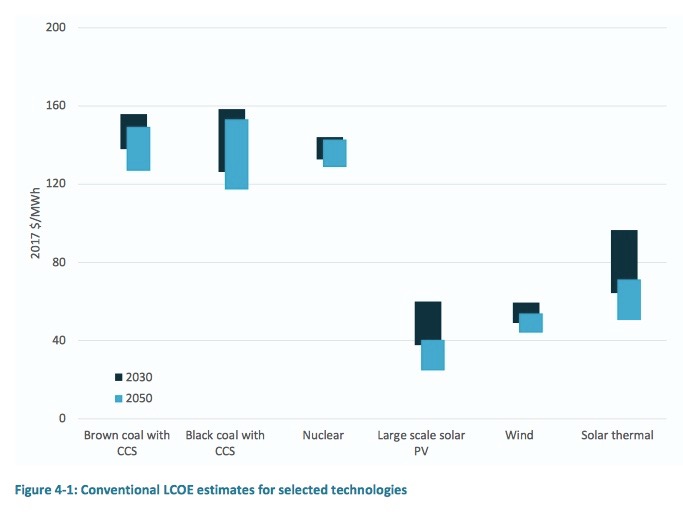
| | The table lists only low emission technologies; the cost of carbon capture and storage (CCS) greatly increases the cost of fossil fuel generation.
| |
Cost of renewable energy
The graphic on the right is from the
CSIRO report "Electricity generation technology projections 2017-2050" by Jenny A Hayward and Paul W Graham, December 2017.
For a full understanding of the table the reader should refer to the CSIRO report.
The CSIRO table does not include the cost of gas fired electricity generation, that is included in a
costings report from the World Energy Council on another page on this site.
The graph and the CSIRO report show clearly that renewables are cheaper than new-build coal-fired (and nuclear) power stations.
| |
This section added
2021/02/13
|
|
Constraints: what is limiting the development of renewables in South Australia?
At this time there are a number of factors that are discouraging further development of wind and solar farms in South Australia:
- It is not uncommon for potential renewables generation to exceed consumption and the maximum amount of power that can be exported;
- Negative and low wholesale prices (linked to excessive generation) are common enough to make building new wind and solar farms in SA unattractive. SA is finding it hard to compete in attracting new sustainable energy developments against the largely coal-powered eastern mainland states that can absorb far more renewable power;
- Green hydrogen production is still in its very early developmental and pilot stages. Very little of the excess generation can be diverted to production of green hydrogen;
- There is no pumped hydro energy storage in SA;
- Battery storage is far smaller than the amount of energy storage needed;
- There are far too few electric cars for them to play a significant part in energy consumption;
- Interconnector capacity is too small to allow exporting SA's excess power to the eastern states.
In the twelve months to the present SA's wholesale electricity prices were the lowest in the NEM, making states with higher prices more attractive to wind and solar developers.
This situation is gradually changing. Probably the most important change to come that can be given a probable date is the SA-NSW power interconnector that is likely to be built by 2025, possibly 2024.
| |
This section added
2022/01/07
|
|
A projection; 100% renewal energy by 2027?
| |
SA generation record, 2007 to 2022
|
|---|

| Graphic extracted from Open NEM
| |
In the graph on the right the green is wind power and the yellow above the green is solar power; both, of course, renewable. The shades of orange are gas-fired power, the brown is coal-fired, and the purple on the bottom is imported power from the eastern states.
Without making a serious arithmetic or exponential projection from the AEMO (Australian Energy Market Operator) data, just eyeballing this graph, suggests that an arithmetic projection would lead to 100% renewable generation in SA by about 2027 and, since the rate of growth of renewables has been increasing, an exponential projection would lead to 100% renewable generation before 2027. Approximate extrapolations from the data that I took from OpenNEM suggested that the trend was toward 100% renewable energy by around 2025 to 2027.
Extrapolations are difficult partly because the rate of growth of the share of solar electricity generation has been 27% per annum from 2012 to 2021 while that of wind power has been only 6.5% per annum over the same period. Solar started the period from a much lower base and at the end of the period the share of wind power was 41% and solar 21%.
Of course a projection or an extrapolation is not a prediction. And getting the first 50% renewable energy is easier than getting the second 50%.
For years there has been a lot of uncertainty in the future of power generation in Australia.
One of the responses to this is for businesses to make their own arrangements for power supply by either installing their own solar power or contracting the owners of wind or solar farms for power supplies.
The consequence of uncertainty in the power generation industry, it seems to me, has been, and will continue to be, for more and more individuals and businesses to switch to renewable energy and therefore increasing amounts of renewable energy being built.
Who should make the decisions that need to be made about South Australia's energy future?
How should they be made?
What aims should there be behind the decisions?
The decisions should be made by an unbiased body that is fully informed and has the required knowledge, or access to that knowledge.
It follows that they should not be made by politicians.
The decisions should be made by a competent and independent body under instruction to:
- Take full account of the economics of the power supply system;
- Consider the future opportunities such as the exporting of energy in one form or another;
- Give a high priority to the reliability of the power supply system;
- Give full consideration to the available technologies and the technologies that are likely to become available in the near future;
- Take into account Australia's commitments and ethical responsibilities to lower greenhouse gas emissions as much as is reasonably possible within economic and technological constraints.













